PAGE 53a – SEPTEMBER 2006
H O T I D E A S F O R S M A L L R A I L R O A D S
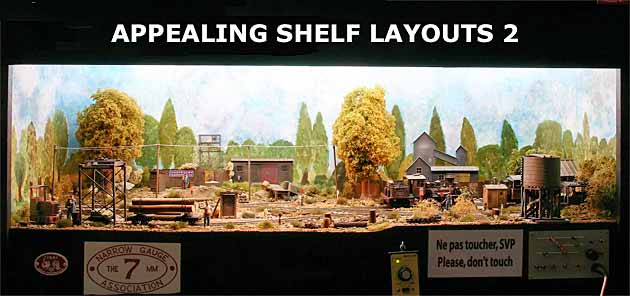
Appearing right on the heels of the first installment of this shelf-layaut collection
are more dramatic examples of how fine scenery and interesting trains can combine
with good operation on a shelf. The frontispiece again is the fine On30/0e layout,
Josephtown Craddonium Co., by Fabrice Fayolle, from Amiens, France (see plan in #24).
L A Y O U T S W I T H T R A V E R S E R S
Traversers (transfer tables) are a very easy and useful way to move cars, locomotives or even entire trains from track to track behind the scenes. Because such tables were used in the prototype, they can also be left in plain sight. Here, however, are several examples of “backstage” traversers, used to keep traffic flowing in the visible part of the layout.
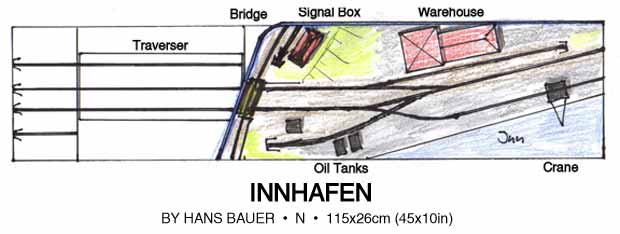
A branch line that was planned but never built provides the backstory for Hans Bauer‘s N scale layout, Innhafen. Hans lives in Wasserburg, Bavaria, Germany, on the Inn river … and the fictional Wasserburg line is featured on his layout, fed by a three-track traverser in the fiddle yard. Naturally the rail line serves river traffic; our attention focuses on the large crane at the waterfront.
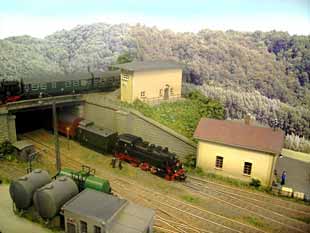
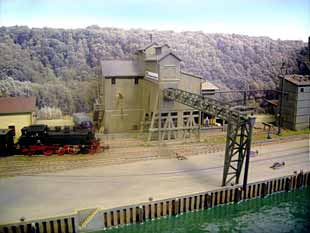
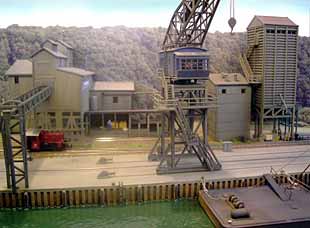
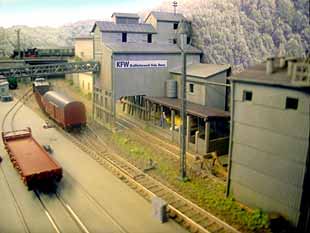
The three-track traverser in the fiddle yard is constructed from metal tracks for drawers, as shown in these photographs (below).
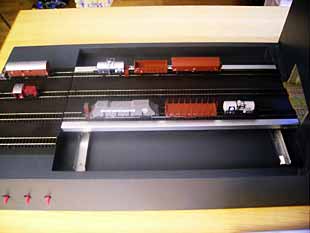
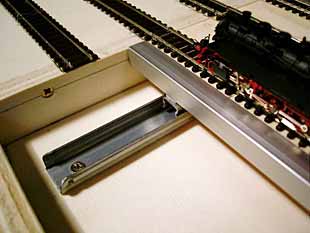


Steve Christopher, from Ottawa, Canada, is building this new version of his original layout, as it was redesigned by Jack Trollope and called Pine Ridge II. Got that? This is Pine Ridge Version II-A! Overall length is 40in, with a detachable 15in traverser. The whole works fits in Steve’s car to take to train shows.
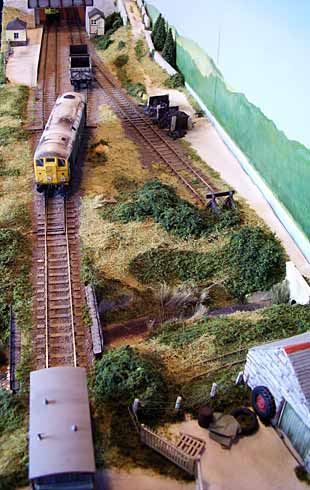
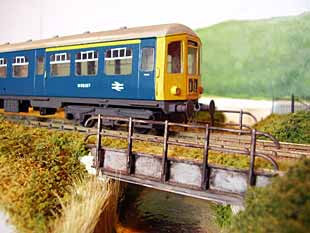
Neil Rushby, from York England, has returned to mid-Wales at the beginnning of the Seventies for his new 6x1ft layout, Abergwynant. It’s EM gauge (4 mm scale on 18.2mm gauge).
The photo at left shows most of the layout and the entire track plan. There’s a concealed three-track traverser just visible behind the bridge at the rear. It both feeds the layout and completes the runaround, much like Pine Ridge II-A above. As there’s a narrow-gauge quarry tramway at the real Abergwynant, Neil included a short, unused stretch of track in his model (right front).
CLIMBING THE HIMALAYAS IN GERMANY
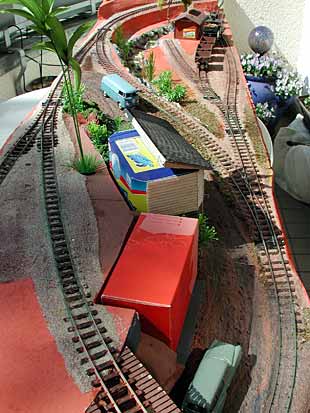 Alexander Kaczmarek, from Berlin, Germany, is building his first On30 layout to depict a portion of the Darjeeling Himalayan Railway in India. His plan, shown under construction at right, is an adaptation of Chuck Yungkurth‘s popular Gum Stump & Snowshoe. Rather than rising up and switching back over itself on a bridge, this line emulates the real DHR and operates as a straight switchback (zig-zag) line.
Alexander Kaczmarek, from Berlin, Germany, is building his first On30 layout to depict a portion of the Darjeeling Himalayan Railway in India. His plan, shown under construction at right, is an adaptation of Chuck Yungkurth‘s popular Gum Stump & Snowshoe. Rather than rising up and switching back over itself on a bridge, this line emulates the real DHR and operates as a straight switchback (zig-zag) line.
The layout measures 210x45cm (83x18in). Alexander is modeling many typical details of the real DHR, including a “muddy road” paralleling the center track of the switchback just as the old British road runs beside much of the real railway’s trackage.
Alexander is still busy building Indian structures and scenery for the line, a process made somewhat more difficult by the fact that he has never been to India! Many details will be required to capture the crowded and exotic flavor of this Himalayan mountain line.
This layout illustrates well the advantages of building a switchback line on a long, narrow shelf. We’ll try to keep you posted on Alexander’s progress. For details of the real DHR, one of the world’s most fascinating railroads, he recommends the DHR Society website.
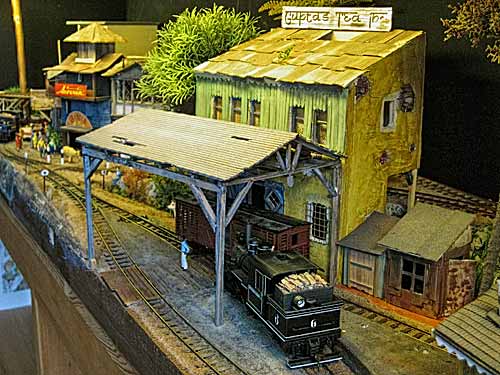
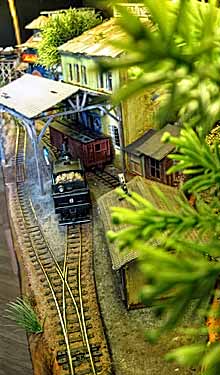
A WORLD WAR I TRENCH RAILWAY MODEL

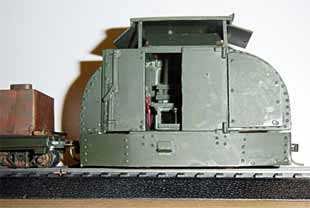 Charlie Bryant, from Asheville, North Carolina, USA, is building this World War I trench railway in 1n20 (1:32 scale on 16.5mm gauge). He’s just begun to build scenery in the photo above, which also shows Charlie’s ingenious PVC plumbing-tube support structure for the shelf… lightweight and easy to dismantle and transport. At left is Charlie’s scratchbuilt “armored Simplex” loco, a 40-hp unit often used in the First World War to distribute supplies at the front lines.
Charlie Bryant, from Asheville, North Carolina, USA, is building this World War I trench railway in 1n20 (1:32 scale on 16.5mm gauge). He’s just begun to build scenery in the photo above, which also shows Charlie’s ingenious PVC plumbing-tube support structure for the shelf… lightweight and easy to dismantle and transport. At left is Charlie’s scratchbuilt “armored Simplex” loco, a 40-hp unit often used in the First World War to distribute supplies at the front lines.
HIS FIRST MICRO LAYOUT
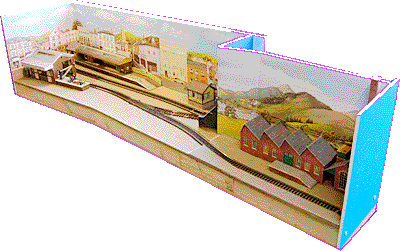 Influenced by the designs on this site, John Sparrow from Wiltshire, England, is building this OO scale micro layout using much of the OO material he has accumulated over the years.
Influenced by the designs on this site, John Sparrow from Wiltshire, England, is building this OO scale micro layout using much of the OO material he has accumulated over the years.
Designed as a simple experimental layout, the pike measures 48x11in (120x28cm). The fiddle yard (behind the sawtooth-roofed factory at right) is a straight track. suitable for Giant Hand Action (GHA).
HERE’S A NEW PEEK’S PIKE VERSION – IN ENGLAND!
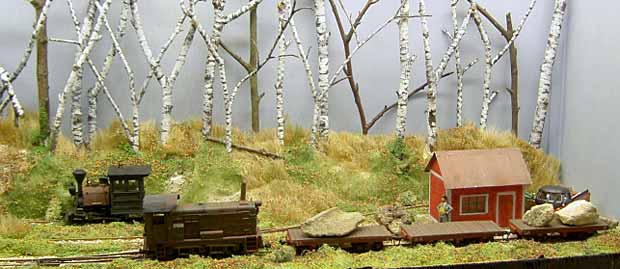
Still under construction but already looking good is this version of Peek’s Pike being built by Martin Hogg, from Mansfield, England. There’s more information in Scrapbook #4. In this progress photo, the birches are looking great! They’re made from real birch branches, but each one had to be painted to make it white and with appropriate markings. The layout has finally acquired a name, reports Martin: it’s called Zebulon Rocks. This intricate pun is based on the title of my layout, Peek’s Pike, which is a play on the name of the well-known American mountain, Pike’s Peak, that in turn was named for Zebulon Pike, an early frontiersman who discovered and named the mountain. Got it?
Visible or hidden, a turntable greatly enhances the operating possibilities of any layout and saves a whole lot of space to boot! Here are some layouts that use turntables effectively “onstage” to get more operation in very small spaces.
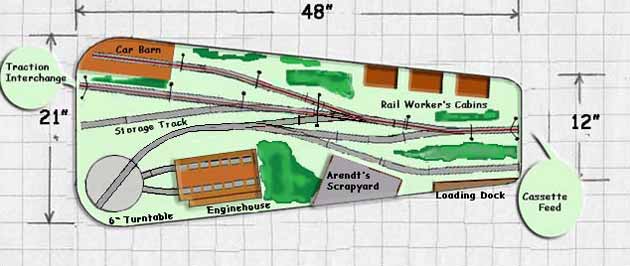
Brian Wilson, from Sidney, British Columbia, Canada, found a way to adapt E.L. Moore‘s Shortline Terminal to a very small shelf, in On30 — including a piece of a traction line! Brian’s clever plan is shown above — notice that the turntable is an integral part of the operations! The key component of operations will be the Interchange track — from regular railroad to traction (under overhead wire). The design evolution of this plan is described well on Brian’s website.Construction is underway — we’ll try to bring you progress reports as Brian develops the line. Shown below are the original E.L. Moore terminal design (at left) and the IKEA shelf unit arrangement that Brian plans as the base for his minimum space layout.
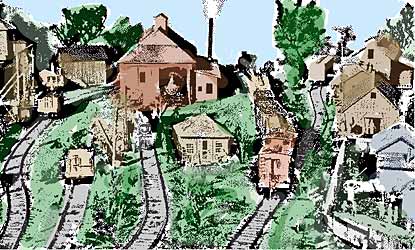
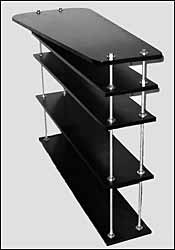
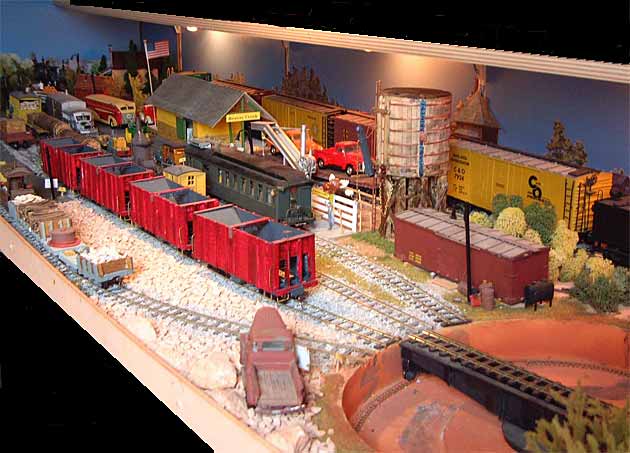

Another design from the ubiquitous Jack Trollope, up in Ross-shire, Scotland, is this design for Jaxcilli Industries IV … the latest in a series of offbeat designs for interesting industrial railways. This one features a small wagon turntable (perhaps created on a used CD disk), which uses three capstans (at A, B and C) to guide a hauling rope by which the loco pulls cars in and out of the building! Note that the loco is not allowed on the turntable (too heavy), and sometimes must use a “reach” wagon (spacer car) to place cars on the table. This is only an experiment at this point, but Jack is determined to give it a try!

INSPIRATION FOR THE HOLIDAYS!

A VERY SMALL DIESEL SERVICING YARD

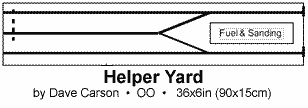
SOME FRESH IDEAS IN GERMAN RAILWAY STATIONS
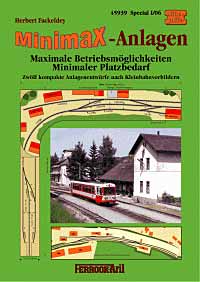 For fans of small layouts with prototype roots, one of this site’s contributors, Herbert Fackeldey, from Aachen, Germany, has written a new book showcasing a variety of German stations and has designed track plans for model layouts based on them. Even better, his publisher, Mittelpuffer magazine, has published both the prototype and model layouts on their website!
For fans of small layouts with prototype roots, one of this site’s contributors, Herbert Fackeldey, from Aachen, Germany, has written a new book showcasing a variety of German stations and has designed track plans for model layouts based on them. Even better, his publisher, Mittelpuffer magazine, has published both the prototype and model layouts on their website!
If you’re interested in unusual fiddle yard designs, German prototype stations, or ways of adapting real track plans to model spaces, this site is a good guide to potential shelf-layouts. If you wish, you can also buy the book there — the descriptions of each layout are quite detailed but are written in German. Summary pages are included in English and French.
MORE INSPIRATION – AN HO/HOn30 INDUSTRIAL LAYOUT
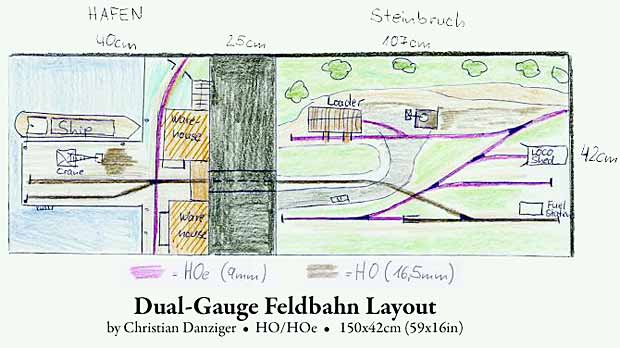
Inspired by this website Christian Danziger, from Kaufering, Germany (near Munich), designed and built a dual-gauge HO/HOe layout, “Die Werksbahnen der Lechfelder Kieswerke” (in English, Lechfeld Quarry Tramway). The layout is built in two sections, each of which required three to four months of work to complete.
The first section (overview below), 107x42cm (42x16in), depicts a stone quarry operation. A narrow gauge tramway hauls sand and gravel from the rock crusher (left rear) to the interchange with the standard (normal) gauge at the front. The crusher loader has two electromagnetic latches so that the railroad car can be filled with sand at the push of a button.
Christian has built a working model of a piggy-back operation in which the standard-gauge open cars are carried to the crusher on a narrow-gauge piggy-back car (“Rollwagen” in German). The photos below show this rollwagen operation. Christian explains, “The Bemo diesel loco on narrow gauge tracks brings the standard-gauge wagon on the Rollwagen to a ramp, where it is pulled onto the standard gauge by the normal gauge loco (a V36 Diesel Loco from Lenz).”
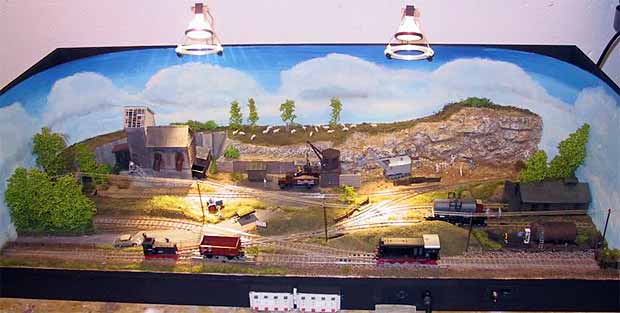
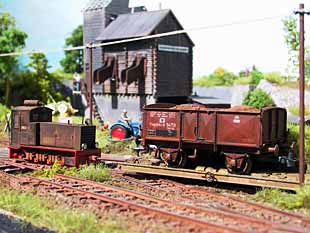
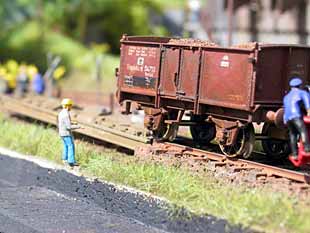
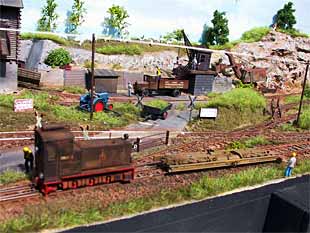
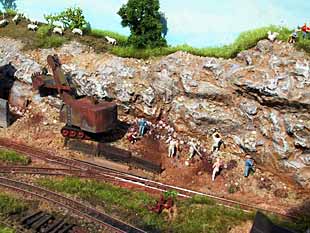
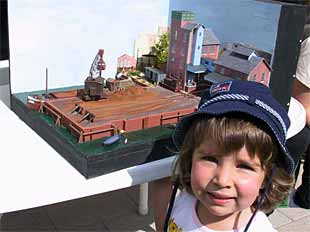
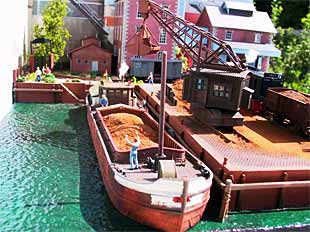
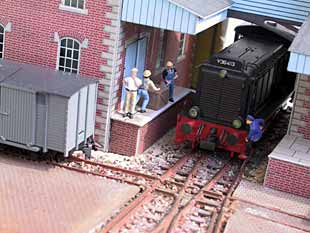
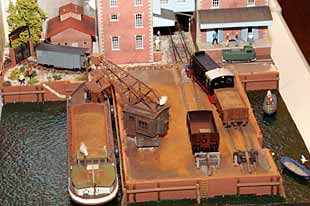
I am just commencing to build a 009/HOe layout. It will be on two tables ,each 1800 x 770 and set at right angles to each other. I live in New Zealand where narrow gauge is virtually unknown and I continually scan Ebay for Locomotives and equipment
Just love seeing these very detailed tiny narrow gauge. Started building a small HOn3 layout using D&RGW equipment. But have moved from a house to a tiny apartment. You have given me a new avenue to travel. Thanks.